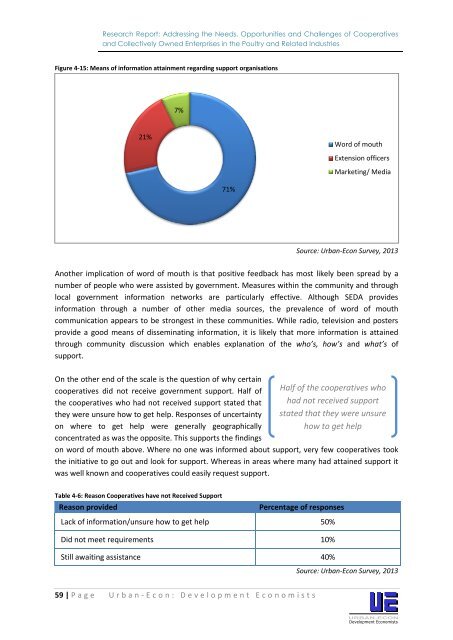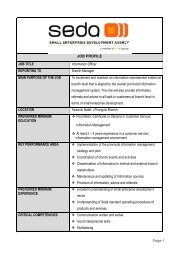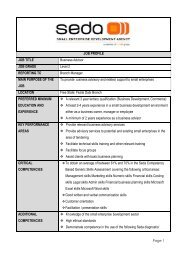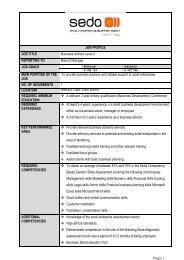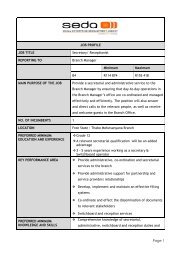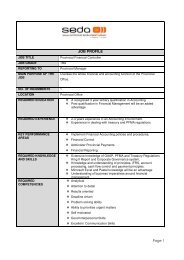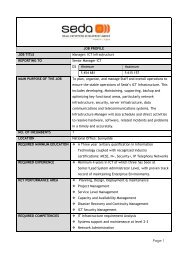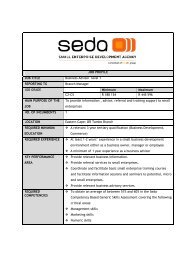Assessment of Cooperatives in the Poultry Industry - 2013.pdf - Seda
Assessment of Cooperatives in the Poultry Industry - 2013.pdf - Seda
Assessment of Cooperatives in the Poultry Industry - 2013.pdf - Seda
Create successful ePaper yourself
Turn your PDF publications into a flip-book with our unique Google optimized e-Paper software.
Research Report: Address<strong>in</strong>g <strong>the</strong> Needs, Opportunities and Challenges <strong>of</strong> <strong>Cooperatives</strong><br />
and Collectively Owned Enterprises <strong>in</strong> <strong>the</strong> <strong>Poultry</strong> and Related Industries<br />
Figure 4-15: Means <strong>of</strong> <strong>in</strong>formation atta<strong>in</strong>ment regard<strong>in</strong>g support organisations<br />
7%<br />
21%<br />
Word <strong>of</strong> mouth<br />
Extension <strong>of</strong>ficers<br />
Market<strong>in</strong>g/ Media<br />
71%<br />
Source: Urban-Econ Survey, 2013<br />
Ano<strong>the</strong>r implication <strong>of</strong> word <strong>of</strong> mouth is that positive feedback has most likely been spread by a<br />
number <strong>of</strong> people who were assisted by government. Measures with<strong>in</strong> <strong>the</strong> community and through<br />
local government <strong>in</strong>formation networks are particularly effective. Although SEDA provides<br />
<strong>in</strong>formation through a number <strong>of</strong> o<strong>the</strong>r media sources, <strong>the</strong> prevalence <strong>of</strong> word <strong>of</strong> mouth<br />
communication appears to be strongest <strong>in</strong> <strong>the</strong>se communities. While radio, television and posters<br />
provide a good means <strong>of</strong> dissem<strong>in</strong>at<strong>in</strong>g <strong>in</strong>formation, it is likely that more <strong>in</strong>formation is atta<strong>in</strong>ed<br />
through community discussion which enables explanation <strong>of</strong> <strong>the</strong> who’s, how’s and what’s <strong>of</strong><br />
support.<br />
On <strong>the</strong> o<strong>the</strong>r end <strong>of</strong> <strong>the</strong> scale is <strong>the</strong> question <strong>of</strong> why certa<strong>in</strong><br />
cooperatives did not receive government support. Half <strong>of</strong><br />
<strong>the</strong> cooperatives who had not received support stated that<br />
<strong>the</strong>y were unsure how to get help. Responses <strong>of</strong> uncerta<strong>in</strong>ty<br />
on where to get help were generally geographically<br />
concentrated as was <strong>the</strong> opposite. This supports <strong>the</strong> f<strong>in</strong>d<strong>in</strong>gs<br />
Half <strong>of</strong> <strong>the</strong> cooperatives who<br />
had not received support<br />
stated that <strong>the</strong>y were unsure<br />
how to get help<br />
on word <strong>of</strong> mouth above. Where no one was <strong>in</strong>formed about support, very few cooperatives took<br />
<strong>the</strong> <strong>in</strong>itiative to go out and look for support. Whereas <strong>in</strong> areas where many had atta<strong>in</strong>ed support it<br />
was well known and cooperatives could easily request support.<br />
Table 4-6: Reason <strong>Cooperatives</strong> have not Received Support<br />
Reason provided<br />
Percentage <strong>of</strong> responses<br />
Lack <strong>of</strong> <strong>in</strong>formation/unsure how to get help 50%<br />
Did not meet requirements 10%<br />
Still await<strong>in</strong>g assistance 40%<br />
Source: Urban-Econ Survey, 2013<br />
59 | P a g e U r b a n - E c o n : D e v e l o p m e n t E c o n o m i s t s


